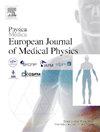Automatic base-dose planning for a robust field junction in total marrow irradiation
IF 3.3
3区 医学
Q1 RADIOLOGY, NUCLEAR MEDICINE & MEDICAL IMAGING
Physica Medica-European Journal of Medical Physics
Pub Date : 2025-02-01
DOI:10.1016/j.ejmp.2025.104898
引用次数: 0
Abstract
Purpose
Total marrow (lymph-node) irradiation (TMI/TMLI) is a radiotherapy technique irradiating the whole body of a patient. The limited couch travel range in modern linacs (130–150 cm) forces to split the TMI/TMLI delivery into two plans with opposite orientation. A dedicated field junction is necessary to achieve satisfactory target coverage in the overlapping region of the two plans. In a recent study, we implemented an automatic tool (AT) using the Eclipse Scripting API for the creation of a field junction and optimization of TMI/TMLI. In this work, we improved the AT by developing an automatic base-dose planning approach.
Methods
Ten patients were selected to compare the manual procedure, original automatic planning approach, and new base-dose approach. Treatment plans were evaluated with the D98%, Dmean, and D2% for the planning target volume at the junction (PTV_J), while Dmean and D2% were considered for the PTV without the junction (PTVNoJ) and healthy tissues.
Results
Base-dose planning significantly improved the PTV_J coverage compared with the manual approach, with unaltered Dmean, consistently lower D2% (2.24 Gy vs. 2.30 Gy) and higher D98% (1.98 Gy vs. 1.89 Gy). Moreover, it significantly reduced the hotspots in healthy tissues (2.02 Gy vs. 2.15 Gy). No significant differences for PTVNoJ dose statistics were observed among the procedures, demonstrating that the automatic approaches produced a target coverage similar to the one obtained manually.
Conclusions
Base-dose planning improved the field junction optimization of TMI/TMLI. Automatic planning tools can incrementally improve procedures that would be challenging or error-prone to achieve manually.
全骨髓照射中一个健壮场结的自动基础剂量规划。
目的:全骨髓(淋巴结)照射(TMI/TMLI)是一种对患者全身进行照射的放射治疗技术。现代直线汽车有限的沙发行程范围(130-150厘米)迫使TMI/TMLI交付分为两个方向相反的计划。为了在两个计划的重叠区域实现令人满意的目标覆盖,必须有一个专门的外地接入点。在最近的一项研究中,我们使用Eclipse Scripting API实现了一个自动工具(AT),用于创建字段连接并优化TMI/TMLI。在这项工作中,我们通过开发一种自动基础剂量规划方法来改进AT。方法:选择10例患者,比较手工方法、原始自动计划方法和新的基础剂量方法。以计划目标体积(PTV_J)的D98%、Dmean和D2%对治疗方案进行评估,而对于没有连接的PTV (PTVNoJ)和健康组织,则考虑Dmean和D2%。结果:与手动方法相比,基础剂量计划显著提高了PTV_J覆盖率,Dmean不变,持续降低D2% (2.24 Gy vs. 2.30 Gy)和提高D98% (1.98 Gy vs. 1.89 Gy)。此外,它显著降低了健康组织中的热点(2.02 Gy vs. 2.15 Gy)。在不同的程序中,PTVNoJ剂量统计数据没有显著差异,这表明自动方法产生的目标覆盖率与人工方法相似。结论:基础剂量规划促进了TMI/TMLI的场结优化。自动计划工具可以逐步改进手动实现的具有挑战性或容易出错的过程。
本文章由计算机程序翻译,如有差异,请以英文原文为准。
求助全文
约1分钟内获得全文
求助全文
来源期刊
CiteScore
6.80
自引率
14.70%
发文量
493
审稿时长
78 days
期刊介绍:
Physica Medica, European Journal of Medical Physics, publishing with Elsevier from 2007, provides an international forum for research and reviews on the following main topics:
Medical Imaging
Radiation Therapy
Radiation Protection
Measuring Systems and Signal Processing
Education and training in Medical Physics
Professional issues in Medical Physics.

 求助内容:
求助内容: 应助结果提醒方式:
应助结果提醒方式:


